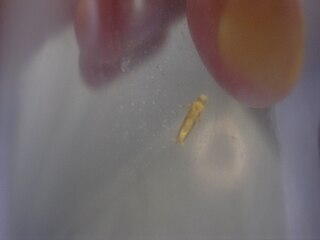
Erechthias minuscula, the erechthias clothes moth, is a moth of the family Tineidae. It was first described by Lord Walsingham in 1897. It is widespread and has been recorded from Africa, Sri Lanka, Java, Australia, the Caroline Islands, Fiji, Samoa, the Marquesas, the West Indies, Hawaii and Florida.
Compsoctena is a genus of moths in the family Eriocottidae. It was erected by Philipp Christoph Zeller in 1852.
Compsoctena numeraria is a moth in the family Eriocottidae. It was described by Edward Meyrick in 1914. It is found in South Africa, where it has been recorded from Gauteng.
Compsoctena terrestris is a moth in the family Eriocottidae. It was described by Edward Meyrick in 1914. It is found in South Africa, where it has been recorded from Gauteng.
Compsoctena delocrossa is a moth in the family Eriocottidae. It was described by Edward Meyrick in 1921. It is found in South Africa and Zimbabwe.
Compsoctena furciformis is a moth in the family Eriocottidae. It was described by Edward Meyrick in 1921. It is found in South Africa and Zimbabwe.
Compsoctena quassa is a moth in the family Eriocottidae. It was described by Edward Meyrick in 1921. It is found in South Africa, Zambia and Zimbabwe.
Compsoctena scriba is a moth in the family Eriocottidae. It was described by Edward Meyrick in 1921. It is found in Lesotho, Malawi, Mozambique, South Africa, Tanzania, Zambia and Zimbabwe.
Compsoctena agria is a moth in the family Eriocottidae. It was described by Edward Meyrick in 1909. It is found in Gauteng, South Africa.
Compsoctena media is a moth in the Eriocottidae family. It was described by Walsingham in 1897. It is found in the Central African Republic.
Compsoctena minor is a moth in the family Eriocottidae. It was first described by Walsingham in 1866. It is found in India.
Compsoctena taprobana is a moth in the Eriocottidae family. It was described by Walsingham in 1887. It is found in Sri Lanka.
Compsoctena thwaitesii is a moth in the Eriocottidae family. It was described by Walsingham in 1887. It is found in Sri Lanka.
Dichomeris evitata is a moth in the family Gelechiidae. It was described by Walsingham in 1911. It is found in Panama.
Dichomeris eurynotus is a moth in the family Gelechiidae. It was described by Walsingham in 1897. It is found in the Central African Republic and Sierra Leone.
Haplochela trigonota is a moth in the family Gelechiidae. It was described by Walsingham in 1911. It is found in Mexico, Panama, Guyana and Brazil.
Scrobipalpa parvipulex is a moth in the family Gelechiidae. It was described by Walsingham in 1911. It is found in Algeria.
Stenoma chalepa is a moth in the family Depressariidae. It was described by Lord Walsingham in 1913. It is found in Panama.
Chlamydastis squamosa is a moth in the family Depressariidae. It was described by Lord Walsingham in 1892 and is found in the West Indies.
Moca radiata is a moth in the family Immidae. It was described by Walsingham in 1897. It is found in the Democratic Republic of the Congo and Gabon.
